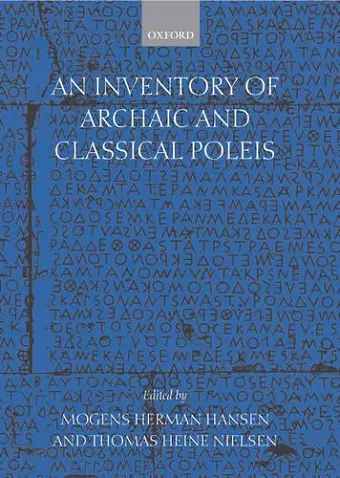An Inventory of Archaic and Classical Poleis
Mogens Herman Hansen author Thomas Heine Nielsen author
Format:Hardback
Publisher:Oxford University Press
Published:11th Nov '04
Currently unavailable, and unfortunately no date known when it will be back

This is the first ever documented study of the 1,035 identifiable Greek city states (poleis) of the Archaic and Classical periods (c.650-325 BC). Previous studies of the Greek polis have focused on Athens and Sparta, and the result has been a view of Greek society dominated by Sophokles', Plato's, and Demosthenes' view of what the polis was. This study includes descriptions of Athens and Sparta, but its main purpose is to explore the history and organization of the thousand other city states. The main part of the book is a regionally organized inventory of all identifiable poleis covering the Greek world from Spain to the Caucasus and from the Crimea to Libya. This inventory is the work of 47 specialists, and is divided into 46 chapters, each covering a region. Each chapter contains an account of the region, a list of second-order settlements, and an alphabetically ordered description of the poleis. This description covers such topics as polis status, territory, settlement pattern, urban centre, city walls and monumental architecture, population, military strength, constitution, alliance membership, colonization, coinage, and Panhellenic victors. The first part of the book is a description of the method and principles applied in the construction of the inventory and an analysis of some of the results to be obtained by a comparative study of the 1,035 poleis included in it. The ancient Greek concept of polis is distinguished from the modern term `city state', which historians use to cover many other historic civilizations, from ancient Sumeria to the West African cultures absorbed by the nineteenth-century colonializing powers. The focus of this project is what the Greeks themselves considered a polis to be.
Allison's book is the first of its kind in Pompeian scholarship and, given the thorough discussion of almost all methodological aspects related to artifact analysis and the detailed descriptions, drawings and photographs of the individual objects, it is likely to become a standard reference point for any scholar working with artifacts and artifact assemblages in the Vesuvian area, so that it belongs in any decent university library. * Miko Flohr, Babesch *
To produce a study of this scope and size is an achievement that should command the highest respect... entertaining and informative * Jan Paul Crielaard, Babesch *
The work is a superb achievement at many different levels * Robert Parker, The Classical Review *
...[a] masterly volume ... a magnificent and essential resource for anyone studying the Greek world. * Greece and Rome *
ISBN: 9780198140993
Dimensions: 252mm x 195mm x 62mm
Weight: 2185g
1416 pages